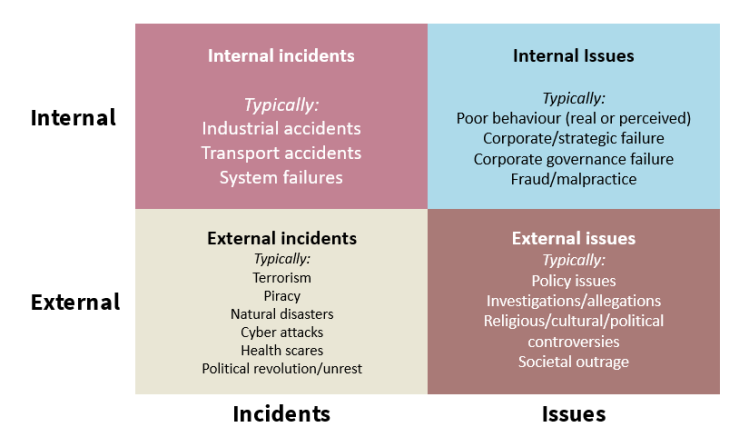Research, evaluation and planning are at the very core of the strategic function of PR. In crisis times, providing a solid basis of information is vital to enable organisations to thrive and survive their hostile environment.
To many extents, issues and crises are relatively predictable. Famously, Bazerman and Watkins describe crises as “predictable surprises”, deploring the broad lack of foresight and planning in business activities.
How much preparation can we do in advance to prepare for a crisis? When do we know we are fully crisis-ready?
1. Know the organisation inside in and out
Crisis preparedness requires us to think about the reputation pillars of our organisations and carefully examine the drivers. This way, we will be able to better and more quickly understand the aspects are directly threatened during difficult times.
In essence, crises become existential crises when the organisation’s promise is undermined by something that has been done or is being done by the organisation. Understanding this promise will be of crucial importance because we can already prepare and predict what can be the most detrimental to reputation.
According to the Reputation Institute, there are 7 key rational domains of reputation professionals should assess:
- Products/Services
- Citizenship
- Innovation
- Leadership
- Workplace
- Performance
- Governance
What identifies a crisis is not the nature of what has happened but what is at stake – reputation, the bottom line, the licence to operate and the future of the organisation
Andrew Griffin in Crisis, Issues and Reputation Management (2014)
Some other important aspects for assessment include the quality and quantity of information at your disposal, the quality of the relationships, the communication networks, the potential bottlenecks and gatekeepers, and the communication patterns of the company (Hargie and Tourish, 2000).
This intelligence will ultimately help practitioners provide a clear definition of what crisis means for them and provide early warnings with an escalation plan to the leadership team.
2. Concentrate on locating and reducing risk
The main reason why certain organisations are hit harder by crises is that they are simply not prepared, or they might not be looking the right way.
Crisis management guru Andrew Griffin, the author of the excellent Crisis, Issues and Reputation Management, explains that crises can come from external or internal sources, and from incidents or issues.

What Griffin’s matrix teaches us is simple. Firstly, risks are omnipresent. Secondly, environment scanning is crucial to find early signs of a crisis and take actions.
Crisis communication efforts are often centered on response strategies. However, the efforts in locating and reducing risks are essential from the start because prevention is better than cure.
The benefits of this are twofold:
- A solid situational analysis constitutes a good basis to work on the messages that will build up resistance to subsequent negative media coverage and reactions;
- An early identification of risks saves time for crisis managers to target key stakeholders, identify relevant medium and agree on clear messages when they will need it the most.
When a crisis hits – because hey, it will happen – the practitioners’ role will be to gather information as quickly as possible, minimise the damage and lay the foundations for repair. This is challenging because making decisions during a crisis often means making decisions with little or no information. But doing your homework in the preparation phase will ultimately give the organisation the chance to do so.